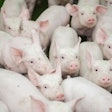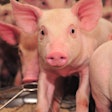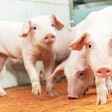
Modern, hyper-prolific genetics have changed the way we feed sows, particularly lactating ones. The reason is simple: sows now produce more piglets, but they have not increased their milk yield accordingly. Yes, they produce more milk than before, but not enough for all piglets, which, by the way, are born with a lower body weight. Thus, not only are piglets weaker, but they also get to share an inadequate supply of milk.
Modern lactating sow feeds are no longer the inexpensive counterparts of rather similar growing-finishing pig diets. Today, lactating sow feeds are comparable to piglet feeds as they must be energy- and nutrient-dense and contain a plethora of additives that enhance the intrinsic value of natural ingredients. Finally, as we head toward a world with reduced antibiotic usage, sows and piglets can no longer rely on medicines for all their troubles under commercial conditions. Therefore, feed has once more become a crucial vehicle of transporting gut-health-supporting additives, one of which is immunoglobulins.
What are immunoglobulins?
Immunoglobulins are not new on the market, and in fact, we have been feeding them in piglet feeds through a number of sources. Suffice it to say here, they are not inexpensive, but they are needed to realize the full great genetic potential of modern sows. So, to begin with, immunoglobulins (also, known as Ig or antibodies) are natural compounds produced by the organism as the last line of defense against invading pathogens (bacteria, viruses, yeasts, etc.). They are extremely effective as they are each designed for every specific invading pathogen, but at the same time, they are very costly for the organism to produce. As such, they become active only when everything else fails (this is why it takes us about 4 to 6 days before we start recovering from the onset of simple flu symptoms).
Immunoglobulins circulate freely in the blood, having been produced in the lymph nodes. Blood products — such as animal plasma — are rich in immunoglobulins (especially IgG). Milk is also another rich source of immunoglobulins (IgA), but one more related to the protection of the mucosa. Also, eggs, being a complete package, contain a dense form of immunoglobulins (IgY) that provide chicks with ready-made immunity.
Immunoglobulins are produced in response to an invading pathogen (an infection or a vaccine). Consequently, all products containing different forms of immunoglobulins contain only such specific Ig as those that the donor animal was exposed. The longer (mature animals) or the stronger (vaccinated) the exposure, the higher the Ig concentration.
Experiences with piglets
In brief, feeding Ig-rich sources in piglets has resulted in improved gut health, leading to enhanced growth potential. All these were evidenced as a dramatic increase in feed intake, irrespectively of feed nutrient density or ingredient complexity. Again, the lower the base performance of piglets, or the higher the level of in-feed immunoglobulins, the higher the result. Not surprisingly, when piglets of exceptionally high health were fed diets with immunoglobulins, no benefits were experienced, leading to the very evident connection between health and performance through nutrition.
The problem with modern sows
Modern sows do not eat enough. If they nurse 14 piglets, each requiring 1 kilogram milk per day to support an adequate growth rate of 250 grams (much more is possible), then sows should have a yield of 14 kilograms of milk per day, requiring a daily feed intake of about 16 kilograms (accounting for maintenance needs). Considering that the best of the sow genetics available today cannot consume more than 10 to 12 kilograms per day, and this only past the first week after birth, we can easily understand that there is a considerable gap. Feeding a more energy-dense diet is not always possible because the extra energy is usually in the form of oil and fats, that become easily oxidized leading to total feed refusal. Plus, mixing and handling a high-oil/fat diet is beyond the abilities of most field facilities. Thus, we need to find other ways to increase sow feed intake or improve the digestibility of ingested feed. Indeed, this is the topic of discussion among pig nutritionists today, and to this discussion the notion of including a source of immunoglobulins is offered as a possible new tool.
Initial evidence and sources
When animal plasma was first discovered in the early 90s, efforts were made to introduce it in sow diets. A level of 0.5 percent (5 kilograms/metric ton) was tested, with positive results — sows consumed more feed, but the practice was not followed through. This was because at that time, sow feed intake was at par with piglet average growth expectations, and although plasma inclusion rate was only one tenth of what was used in piglet feeds, it was still an expensive proposition for a simple diet such as that used for lactating sows. Nevertheless, the initial evidence remains and it is now time to reopen this discussion. As it happens, there are now even more advantages to using immunoglobulins sources, each to be discussed in turn next.
- Milk products. Dried whey contains 2 to 3 percent IgA, whereas whey protein concentrate contains even more. In fact, adding sweet whey at 50 kilograms per metric ton is an old recipe to enhance sow feed intake, perhaps due to this otherwise insignificant contribution of IgA. Using whey protein concentrate is a more expensive proposition, but this ingredient brings also an appetizing factor that is not there for other such products. Finally, milk products are rich in bioactive peptides and other biofactors that remain largely unexplored, and these can also be attributed a generally positive role towards gut health. The only problem with milk products is that they are not as effective as the other sources, at least in the economically feasible range of inclusion rates. In addition, IgA is a rather weak and unspecific form of immunoglobulins, different to IgG and IgY that are highly specific to pathogens.
- Blood products. Animal plasma remains the most well-known source of immunoglobulins, containing about 15 percent IgG, along with several active compounds that are nowadays being recognized as equally important to Ig (for example, systemic anti-inflammatory action), at least in piglets that suffer from post-weaning diseases. This ingredient was the basis of discovering the role of Ig in animal nutrition in the early 90s, and has gone through much investigation, which is still undergoing, giving it new roles against diseases. Of course, there are not only positives to this ingredient, with IgG levels being variable and prices high, whereas all concerns about quality in modern products have now been addressed by the major manufacturers.
- Egg products. Feeding dried eggs (without the shell) is not a feasibly way to concentrate enough immunoglobulins for practical purposes — simply this ingredient is unavailable as it is used in human nutrition. Instead, designed eggs are produced from hens exposed to specific pig pathogens, producing an IgY-rich product. The beneficial effects of this product in piglets remain unquestionable, whereas now it is being tested as a routine supplement for sows. In addition, like the ingredients above, eggs contain much more than IgY, with lysozyme being a well-known antibiotic-like compound. Again, quality remains the major factor, and even the concentration/profile of IgY can be a matter of discontent, as not all manufacturers follow the same production methods. High quality products remain expensive.
Immunoglobulin sources, quality
A number of immunoglobulin sources are already available, and they are used extensively to increase feed intake in piglets. Such a notion can be applied in lactating sow feeds, but evidence remains preliminary, warranting more in-depth investigation. The presence of several biofactors in all relevant ingredients can also be a matter of further discussion. Finally, product quality is the only factor that could potentially skew results, whereas high-quality products are available at considerable cost. It remains to be seen if such expense can be justified, but it is not permissible to ignore this potential when additives of a weaker accord are now routinely used in lactating sows of hyper-prolific genetic potential.

















